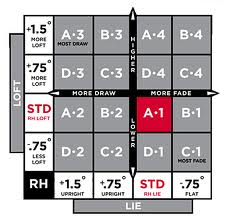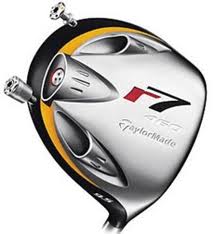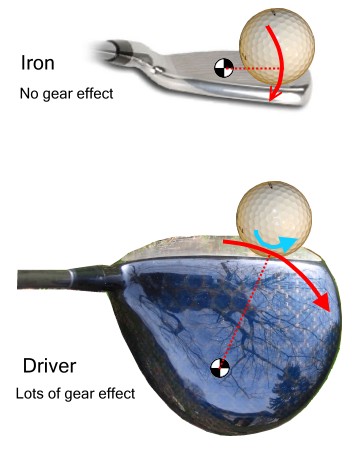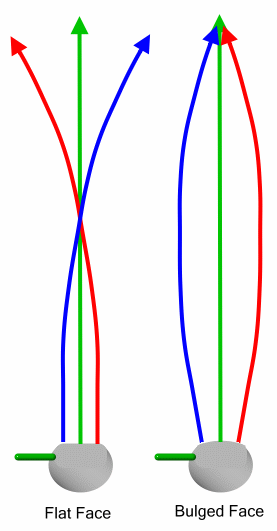The Driver and Accuracy (Part 2)
/
We all want to hit the ball straight and far of the tee don't we? In more technical terms our goals with the driver are to achieve the highest ball speed possible (distance), along with the desired flight pattern (accuracy). We want cake and we want to eat it too! Here's a run down on what club manufacturers have been working on to help us keep the ball in the fairway...
The primary factors directed towards accuracy are bulge and gear effect, center of gravity placement, adjustable heads or weights, a preset face angle and the clubhead design.
- The most interesting element built into each driver that serves to increase accuracy is the one two punch of bulge and horizontal gear effect. The face of every driver (all clubs requiring a headcover for that matter) has roll and bulge while irons do not. Bulge is the curvature of the face from its heel to its toe, while roll is the curvature of the face from the crown to the sole. Bulge starts the ball farther to the right on toe shots and farther to the left on heel shots and is a correction for the clubhead’s center of gravity (CoG) that causes hooking or slicing (gear effect) on off center shots. In other words, manufacturers have built bulge into the face to counter the negative results of gear effect. Here is an explanation (BTW Irons do display gear effect just far less than drivers):
Here's a definition of gear effect from Dave Tutelman (who has an excellent site for the scientist golfers out there):
Gear effect causes a ball to have sidespin which is the result of an off-center hit with a club whose center of gravity is well back from the clubface.
Without an off center hit and a CoG that is well behind the face gear effect cannot happen. In the picture above, we have a toe impact with an iron and a driver. The center of gravity (CoG) is indicated by the black and white circle. The collision between the clubface and the ball on the toe creates a torque that causes the club to twist - the club twists around the clubs' CoG which is indicated by the red arrow.
The CoG on the iron is virtually on the face and this type of strike causes the face to rotate open. This invariably causes the ball to fly weakly to the right as there is no gear effect on the spin imparted on the ball.
The driver is very different. With the CoG being further back from the face a toe impact causes the entire face to rotate around the CoG. As the ball compresses and grips on the face the red arrow causes the ball to actually rotate to the left (blue arrow) - the ball and the face actually work like two gears! Thus the term gear effect. And the reason why a toe hit with a driver tends to hook and a a heel hit tends to fade. Bulge helps out by launching a toe hit to the right of the target - a good thing if the ball has draw spin.
- The design and shape of the clubhead is something that we have seen much tinkering with in recent years. From the triangular Titleist 907 D1 (how could you forget that!) to the onslaught of ugly square heads - these designs all strive to do one thing - re-position the CoG to stabilize the head during off center hits. The longer (from face to back) the clubhead is, the further back the center of gravity is from the face which also increases gear effect. If you can deal with the aesthetics of these scientifically upgraded clubs by all means have at it.
- Another modern trend that has been proven to straighten wayward tee balls is the advent of adjustable weights or screws on the clubhead. Originally introduced by TaylorMade in their R7 line, tests have shown that the higher the swing speed the more a golfer is able to curve a ball by
 changing the weights in the clubhead. A golfer with a swing speed of 115mph (PGATour average is 112mph) will experience 35 yards of curve while a golfer with an average type speed of 85 mph will only experience 6 yards of corrective curve.
changing the weights in the clubhead. A golfer with a swing speed of 115mph (PGATour average is 112mph) will experience 35 yards of curve while a golfer with an average type speed of 85 mph will only experience 6 yards of corrective curve. - Along similar lines are the adjustable heads where the shaft rotates in order to adjust the loft or lie. While changing the loft will not do much to improve your accuracy, altering the lie angle can help you make subtle changes. Moving the shaft to a more upright position will promote a draw, while flattening will promote a fade.
- There is also the preset face angle. For those golfers out there who struggle with slicing this has been a tremendous help. If you feel like you could benefit from this just look for on offset driver or one that says draw somewhere on the head.
There are also rumors that there are certain shafts (Nunchuk) that make the ball go straighter, but I have not read anything or seen any convincing evidence to support this.
Thanks for reading and I hope that now you have a better understanding of what your driver can do for you....










